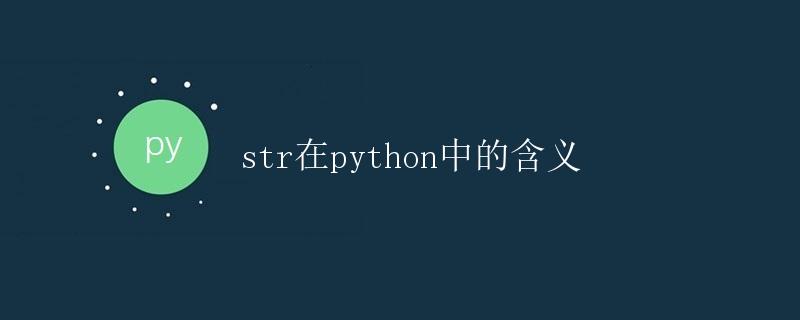str在python中的含义

引言
在Python中,str是一个经常使用的数据类型,用于表示字符串。字符串是由字符组成的,是编程中常见的数据类型之一。本文将详细介绍str在Python中的含义、特性以及常用操作方法。
字符串的定义
字符串是由字符组成的不可变序列,可以用单引号或双引号括起来。例如:
str1 = 'Hello World'
str2 = "Python Programming"
在Python中,单引号和双引号可以互相嵌套,这一点非常方便。比如:
str3 = "It's a beautiful day."
str4 = 'He said, "Welcome"'
字符串的属性和特点
- 不可变性:字符串是不可变对象,即创建后无法修改。对字符串进行任何修改操作,都会生成一个新的字符串。例如:
str = 'Hello'
new_str = str + ' World'
print(new_str) # 输出:Hello World
print(str) # 输出:Hello
- 序列性:字符串是一个有序的字符序列,每个字符都有一个对应的索引(从0开始)。可以通过索引访问和操作字符串中的字符。例如:
str = 'Python'
print(str[0]) # 输出:P
- 可迭代性:字符串可以被迭代,因此可以使用循环遍历字符串中的每个字符。例如:
str = 'Hello'
for char in str:
print(char)
输出:
H
e
l
l
o
- 字符串拼接:可以使用加号(+)将两个字符串拼接在一起。也可以使用乘号(*)将一个字符串重复多次。例如:
str1 = 'Hello'
str2 = 'World'
new_str = str1 + ' ' + str2
print(new_str) # 输出:Hello World
str3 = 'Python '
new_str = str3 * 3
print(new_str) # 输出:Python Python Python
字符串常用操作
字符串长度
可以使用len()函数获取一个字符串的长度。例如:
str = 'Hello World'
length = len(str)
print(length) # 输出:11
字符串切片
字符串切片是指从一个字符串中截取指定的一段子串。通过指定起始位置和结束位置即可切片。切片的范围是左闭右开区间。例如:
str = 'Hello World'
sub_str = str[6:11]
print(sub_str) # 输出:World
如果不指定起始位置,默认从头开始切片;如果不指定结束位置,默认切片到末尾。例如:
str = 'Hello World'
sub_str1 = str[:5]
sub_str2 = str[6:]
print(sub_str1) # 输出:Hello
print(sub_str2) # 输出:World
字符串查找
可以使用in关键字判断一个字符串是否包含另一个子串。如果包含,返回True,否则返回False。例如:
str = 'Hello World'
if 'World' in str:
print('包含')
else:
print('不包含')
字符串连接
可以使用+将两个字符串连接起来,生成一个新的字符串。例如:
str1 = 'Hello'
str2 = 'World'
new_str = str1 + ' ' + str2
print(new_str) # 输出:Hello World
字符串格式化
字符串格式化是将变量的值插入到字符串中的一种方式。在字符串中使用花括号{}作为占位符,将要插入的变量放在花括号中。例如:
name = 'Alice'
age = 25
str = 'My name is {} and I am {} years old.'.format(name, age)
print(str) # 输出:My name is Alice and I am 25 years old.
字符串拆分
可以使用split()方法将一个字符串根据指定的分隔符拆分成多个子串,返回一个列表。例如:
str = 'Hello World'
list_str = str.split(' ')
print(list_str) # 输出:['Hello', 'World']
字符串替换
可以使用replace()方法将一个字符串中的指定子串替换为另一个字符串。例如:
str = 'Hello World'
new_str = str.replace('World', 'Python')
print(new_str) # 输出:Hello Python
字符串大小写转换
可以使用lower()方法将字符串中所有字符转换为小写,使用upper()方法将字符串中所有字符转换为大写。例如:
str = 'Hello World'
lower_str = str.lower()
upper_str = str.upper()
print(lower_str) # 输出:hello world
print(upper_str) # 输出:HELLO WORLD
字符串判断
可以使用以下方法判断一个字符串的特性:
isalpha():判断字符串是否只包含字母。isdigit():判断字符串是否只包含数字。isalnum():判断字符串是否只包含字母和数字。isspace():判断字符串是否只包含空格。startswith():判断字符串是否以指定的子串开头。endswith():判断字符串是否以指定的子串结尾。
结论
str是Python中的一个重要数据类型,用于表示字符串。字符串具有不可变性、序列性和可迭代性的特点,提供了许多常用的操作方法。掌握了这些字符串的特性和操作方法,能够更好地处理和操作字符串,提高编程效率和代码质量。
 极客教程
极客教程